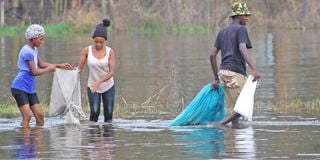Revealed: Why fish in Lake Nakuru are dying

Residents of Barut fish in Lake Nakuru. The lake’s fish have been dying, prompting research into the incidents.
What you need to know:
- Nitrate levels from 0 – 40 ppm are generally safe for fish and anything greater than 45 milligrammes per litre is toxic.
- According to research, nitrates, which are fertilisers, lead to superfluous growth of algae.
- With a new research showing that lakes are warming, the fish at Lake Nakuru are more threatened than ever.
In January last year, Kenya Wildlife Service (KWS) officers woke up to a spectacle - hundreds of fish had died in Lake Nakuru.
In just one month, there were three such incidents of fish dying in the lake, prompting research into the cause.
Researchers from the KWS and Kenya Marine and Fisheries Research Institute established that high concentration of nitrates was to blame for the deaths. Although nitrates are not harmful in normal concentration, they are dangerous to not only marine life but also human beings in high concentrations.
“Based on the high levels of nitrates, having considered that nitrates are toxic in amounts greater than 45 mgl-1, it can be concluded that the environmental conditions for the fish found in Lake Nakuru are not optimum for their growth and reproduction,” said the research findings released recently.
The researchers assessed the prevailing environmental conditions of Lake Nakuru. “Mean dissolved oxygen was 4.8mgl-1 with the maximum at 11.5 mgl-1 while the lowest was 0.07 mgl-1 in the middle of the lake. Mean PH was 8.9 with a maximum of 9.5 while the minimum was 9.3,” found the study.
Algae biomass
The lake’s salinity mean was 4.2 and the highest concentration of nitrates was 67.6 mgl-1 and the lowest was 36.2 mgl-1, meaning that generally, the lake is toxic for fish growth.
“This is indicative of organic and inorganic discharge into the lake possibly originating from industrial or municipal waste,” states the report.
Nitrate levels from 0 – 40 ppm are generally safe for fish and anything greater than 45 milligrammes per litre is toxic.
On the other hand, the concentration of chlorophyll at high levels indicates excessive nutrient loads in the water. It could also be an indication of degraded water quality leading to an increase in algae biomass.
Coupled with other environmental factors fish catches in Lake Nakuru could dwindle with time as sewage pollution takes a toll on the lake.
The researchers found that the lake was polluted with sewage from the neighbouring Nakuru town, contributing to the high levels of nitrates and chlorophyll killing fish.
Nakuru town has been growing exponentially over the past few years, resulting in higher lake pollution. Although nitrates mostly come from animal waste, untreated human sewage is also a major source in surface and ground water.
But, how do nitrates lead to the death of fish and marine life? According to research, nitrates, which are fertilisers, lead to superfluous growth of algae.
The growth of algae is an indication of degraded water quality and their “availability in large numbers leads to increased biomass of zooplanktons. The most kind of zooplanktons which were found in Lake Nakuru were diaptomus spp.
Algae, like other plants, use nitrates as a source of food. If algae get too much nitrates, they grow in volume. As a result, high concentrations of algae cause extreme flux of dissolved oxygen.
Diluted water
Algae produce oxygen through photosynthesis during the day. But at night, the oxygen can drop to very low levels - because as large numbers of bacteria feed on dead and decaying algae and other plants, they consume the oxygen in large volumes, depleting it.
Fish, like all other animals, need oxygen to survive and depletion of clean air at night kill them.
Apart from high nitrate levels, in the past several years Lake Nakuru has been rising as a result of increased precipitation, pollution, siltation and sedimentation, putting fish in danger. Lake Nakuru, which is alkaline, has been diluted by the increasing water volumes.
For years, the lake has been inhabited by Sarotherodon alcalicum graham, a small Cichlid fish able to tolerate harsh conditions. But now, the fish species composition has changed to include an additional three Cichlid species. The change in the salinity of the lake is expected to affect fish population as well as change the composition of the fish. Currently, it is dominated by O niloticus (Nile tilapia) and O leucostictus.
The Nile tilapia was found to be most affected by the nitrates in the lake. The researchers found that the fish was not increasing in weight and but was growing fast in length.
With a new research showing that lakes are warming, the fish at Lake Nakuru are more threatened than ever.
Fish from Lake Nakuru is supplied not only in the county but to other places like Nairobi. Any decline in the amount of fish harvested there is expected to be felt in the markets.



